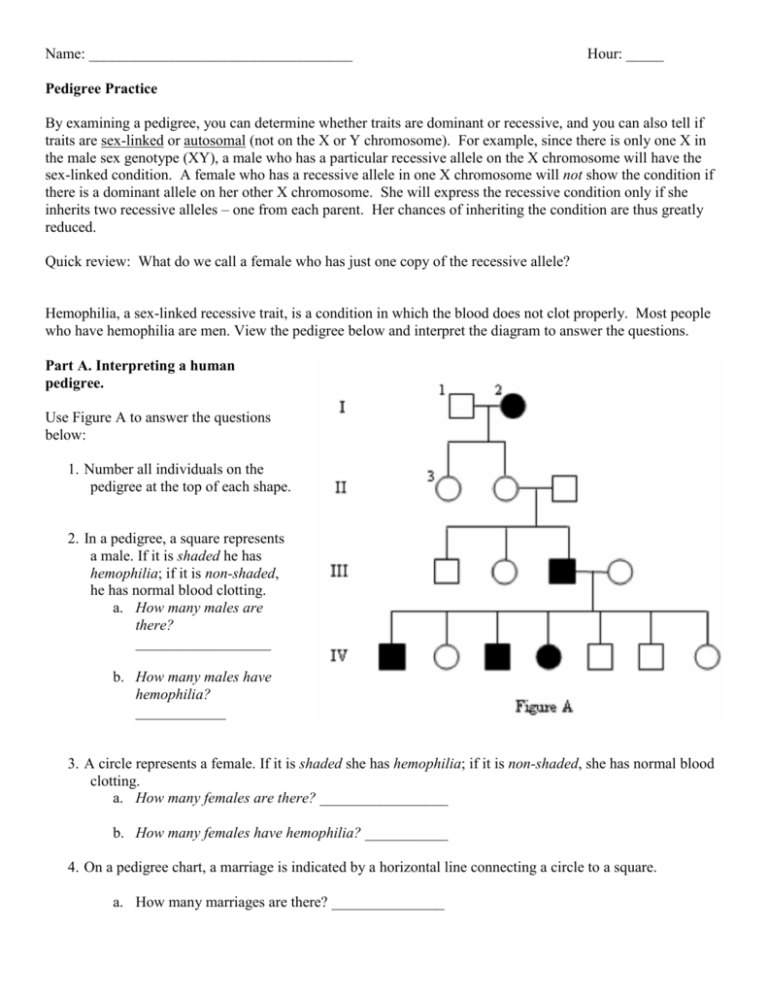Pedigree Practice
advertisement

Name: ___________________________________ Hour: _____ Pedigree Practice By examining a pedigree, you can determine whether traits are dominant or recessive, and you can also tell if traits are sex-linked or autosomal (not on the X or Y chromosome). For example, since there is only one X in the male sex genotype (XY), a male who has a particular recessive allele on the X chromosome will have the sex-linked condition. A female who has a recessive allele in one X chromosome will not show the condition if there is a dominant allele on her other X chromosome. She will express the recessive condition only if she inherits two recessive alleles – one from each parent. Her chances of inheriting the condition are thus greatly reduced. Quick review: What do we call a female who has just one copy of the recessive allele? Hemophilia, a sex-linked recessive trait, is a condition in which the blood does not clot properly. Most people who have hemophilia are men. View the pedigree below and interpret the diagram to answer the questions. Part A. Interpreting a human pedigree. Use Figure A to answer the questions below: 1. Number all individuals on the pedigree at the top of each shape. 2. In a pedigree, a square represents a male. If it is shaded he has hemophilia; if it is non-shaded, he has normal blood clotting. a. How many males are there? __________________ b. How many males have hemophilia? ____________ 3. A circle represents a female. If it is shaded she has hemophilia; if it is non-shaded, she has normal blood clotting. a. How many females are there? _________________ b. How many females have hemophilia? ___________ 4. On a pedigree chart, a marriage is indicated by a horizontal line connecting a circle to a square. a. How many marriages are there? _______________ Name: ___________________________________ Hour: _____ 5. On a pedigree chart, a line perpendicular to a marriage line indicates the offspring. If the line ends with either a circle or a square, the couple had only one child. However, if the line is connected to another horizontal line, then several children were produced. The first child born appears to the left and the last born to the right. a. How many children did the first couple (couple in row I) have? ______________ b. How many children did the third couple (couple in row III) have? _____________ 6. Level I represent the first generation; level II represents the second generation, and so on. a. How many generations are there? _______________ b. How many members are there in the fourth generation? _____________ 7. The genotypes of the males in a pedigree for sex-linked inheritance are easy to determine since normal blood clotting (N) is dominant and hemophilia is recessive (n). Since these alleles are on the X chromosome only, a male represented by a non-shaded square will have the genotype XNY and male represented by a shaded square will have the genotype XnY. Label the following under each individual on the pedigree: a. What is the genotype for Individual #1? ____________ Phenotype? _________ b. What is the genotype for Individual #10? ___________ Phenotype? _________ c. What is the genotype for the first born male in generation III? ______________ Phenotype? _________ 8. Females with hemophilia have an easy genotype to identify. They are all XnXn. Both recessive alleles must be present for a female to have hemophilia. If one dominant allele is present (XN), the female is normal for clotting. a. How many females have the genotype XnXn? _____________ 9. Females who do not show the trait for hemophilia may be homozygous dominant (XN XN meaning they are normal) or heterozygous (XNXn meaning they are carriers). By examining offspring we can often determine which genotype the parents have. For example, if any child (son or daughter) has hemophilia, then the mother must be heterozygous or must also have hemophilia, since she had to give the offspring a Xn allele. a. If a son has hemophilia, does the father have to also have hemophilia? WHY? b. If a daughter has hemophilia, does the father have to also have hemophilia? WHY? Name: ___________________________________ Hour: _____ Part B. Determining the pattern of inheritance and assigning genotypes. When working through a pedigree, you may not always be told which phenotype is dominant and which is recessive. If this is the case, you must use what you know about inheritance patterns in order to determine if the shaded or non-shaded shapes are dominant. Remember that recessive individuals are always homozygous, so it is easiest to assign these genotypes first (two lower-case letters; for example: aa). Then look at all of the dominant individuals. Remember, in classic Mendelian genetics, dominant individuals can be homozygous (example: AA) or heterozygous (example: Aa). For some individuals, you will only be able to determine one allele of the genotype, so just write the one capital allele followed by a dash (for example: A_). Let’s practice determining inheritance and assigning genotypes to individuals on the pedigree chart below: 1. Which phenotype (white or black) is dominant? 2. Which phenotype (white or black) is recessive? 3. How do you know?? 4. Determine the genotypes of all the individuals listed in the pedigree. Write these genotypes below the shapes. Of the 16 individuals included in the chart, 3 of them will have the genotype A_ (meaning you cannot determine if that dominant individual is homozygous or heterozygous). For all other individuals, you should be able to determine both alleles of the genotype.











